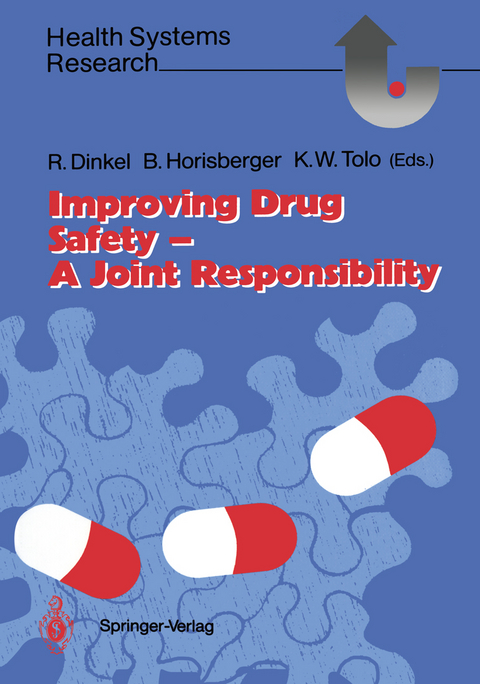
Improving Drug Safety — A Joint Responsibility
Springer Berlin (Verlag)
978-3-642-64762-8 (ISBN)
I: The Wolfsberg Dialogue.- 1. From Questions to Missions and Actions.- 2. The RAD-AR Agenda.- II: Welcoming Addresses.- 3. Council for International Organizations of Medical Sciences.- 4. International Federation of Pharmaceutical Manufacturers Associations.- 5. Intercantonal Office for the Control of Medicines.- 6. RAD-AR Consortium.- III: Ethical Perspectives.- 7. The Discipline of Ethics.- 8. Ethics and Health.- 9. A Biomedical Ethical Perspective.- 10. Corporate Ethics.- 11. Discussion.- IV: Generating Knowledge About Drug Risks.- 12. Categories of Risk and Worldwide Resources.- 13. International Risk Assessment.- 14. Resources Needed for Risk Assessment.- V: Generating Knowledge About Drug Benefits.- 15. Quality of Life and Health Status: Innovative Outcome Variables for Research in Population Health.- 16. The Socioeconomic Evaluation of Medicines: A New Dimension.- 17. Expanding Measures of Benefit in Socioeconomic Studies.- VI: Assessing the Risk/Benefit Relationship.- 18. Challenges in Benefit/Risk Appraisal.- 19. Analysis and Synthesis of Adverse Drug Reaction Evidence.- 20. The Complexities of Assessment.- 21. A Review of the Regulatory Process in Japan.- 22. Postmarketing Surveillance in Japan: An Industry View.- 23. Distortions in Risk Assessment.- 24. Weighing Risk/Benefit Assessment: Views of a Swedish "Regulator".- 25. Scientific Evaluations and Personal Judgments.- 26. Discussion.- VII: Expections in Drug Safety Communication.- 27. The Challenge of Communicating Drug Safety Information.- 28. The Media Perspective.- 29. The Culture of Weighing.- 30. Patient Package Inserts: Carriers of Consensus Information.- 31. The Patients' View.- 32. Patient Motivation.- 33. Japans's Other Drug Market: Exports via Tourists.- 34. Controlling Drug Safety:Making Cautious Changes.- 35. Discussion.- VIII: Experiences in Drug Safety Communication Through Traditional Channels.- 36. Principles, Experiences, and Desired Actions.- 37. Physician-Patient Communication and Decision Making.- 38. Problem-Oriented Drug Information Services.- IX: Responses Beyond Traditional Communication Channels.- 39. Manufacturer Standards for Communicating Risks and Benefits.- 40. Health Behavior Change via Community Education.- 41. Risk Perception: Analyzing Images and Fears.- 42. New Channels for the Patients.- 43. The Patients-in-the-Know Program.- 44. Information for the Public: A Swedish Example.- 45. Discussion.- X: RAD-AR Activities.- 46. International Overview.- 47. RAD-AR Council Japan.- XI: Reports and Recommendations from the Working Groups.- 48. Generating and Assessing Knowledge.- 49. Dialogue and Communication.- XII: Ethical Perspectives Revisited.- 50. Applying Ethics.- 51. Moral Common Sense.- 52. Guiding Principles.- XIII: An Agenda for Action.- 53. Future Directions.- 54. Wolfsberg Think Pieces.- 55. Bibliography.- 56. RAD-AR Bibliography.- 57. Curriculum Vitae of Authors and Editors.- 58. International Life Sciences Institute.- 59. International Medical Benefit/Risk Foundation - RAD-AR.- 60. Subject Index.
| Erscheint lt. Verlag | 26.9.2011 |
|---|---|
| Reihe/Serie | Health Systems Research |
| Zusatzinfo | XXI, 338 p. |
| Verlagsort | Berlin |
| Sprache | englisch |
| Maße | 170 x 242 mm |
| Gewicht | 622 g |
| Themenwelt | Medizin / Pharmazie ► Allgemeines / Lexika |
| Medizin / Pharmazie ► Medizinische Fachgebiete ► Pharmakologie / Pharmakotherapie | |
| Medizin / Pharmazie ► Pharmazie | |
| Schlagworte | addiction therapy • Arzneimittel • Arzneimittelsicherheit • Arzneitherapie • Arzneitherapie / Arzneibehandlung • Assessment • Bewertung der Therapie mit Arzneimitteln • Drogenrisiko/Nutzen-Bewertung • Drogensucht • Drug • Drug risk/benefit appraisal • drug safety communications • ethics • regulatiory fo evaluation of drug therapy • regulatorische Trends • Research • scientific assessments • Suchttherapie • therapy • wissenschaftliche Bewertung |
| ISBN-10 | 3-642-64762-6 / 3642647626 |
| ISBN-13 | 978-3-642-64762-8 / 9783642647628 |
| Zustand | Neuware |
| Haben Sie eine Frage zum Produkt? |
aus dem Bereich


